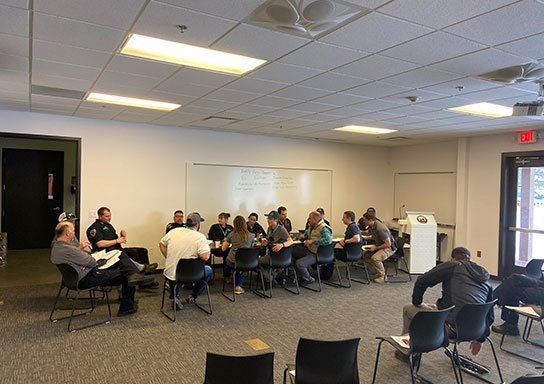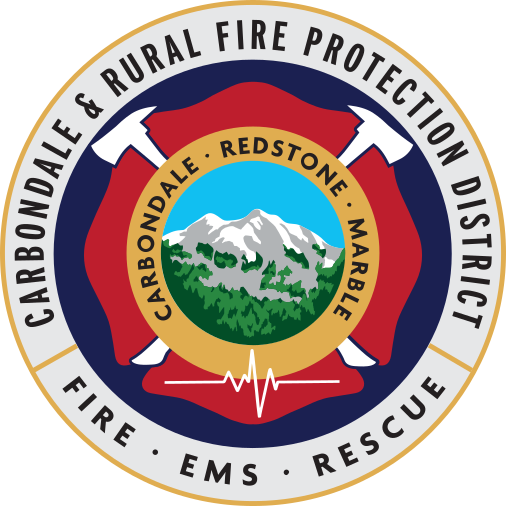Neighbors Helping Neighbors
By admin Published May 29, 2020

Have you ever wondered what an Incident Management Team (IMT) is and what exactly they do? Did you know that the Carbondale Fire District has their own IMT that helped firsthand in the COVID-19 crisis in the Roaring Fork Valley? We’re taking the time this month to answer these questions and to shine some light on some different things that the Fire District does in our community (in addition to fighting fires).
What is an incident management team (IMT)?
An Incident Management Team is a group of people that are assigned different roles in order to establish a well informed and executed plan for a specific incident. An IMT is assembled and driven by the severity of the circumstance. The Carbondale Fire District has their own internal team which includes Bill, Pablo, and Jenny, who are ready at all times to help out with an incident (regardless if it is in their jurisdiction or not). It’s easy to think of an IMT in terms of a project management system, starting with the incident commander at the top and delegating the responsibilities and duties to the other incident managers.
There are eight different positions on the team:
- Incident Commander: The lead on the team, responsible for the execution of the plan
- Public Information Officer: In charge of sharing information to the team and the public
- Safety Officer: Makes sure the IMT is safe and the area is clear of hazards
- Liaison Officer: A point of contact for representatives from assisting and cooperating agencies
- Operations Chief: Plans the operation
- Planning Section Chief: Develops the plan
- Logistics Chief: Secures the resources needed to execute the plan
- Finance Section Chief: Secures funding for necessary resources
All of these people are highly trained in their specific roles and come together to support each other the best they can.
Who was on the IMT in Pitkin County and what were their roles?
When the novel Coronavirus broke out in Pitkin County in March, the government agencies in the county had to act fast and assemble the best team they could in order to help protect our communities. Due to the nature of this pandemic, there were 3 unified incident commanders:
- Karen Koenemann: Director of Pitkin County Public Health
- Gabe Muthing: Director of Aspen Ambulance District
- Alex Burchetta: Pitkin IMT Organizer, Pitkin County Sheriff’s Department Chief Deputy of Operations
These unified commanders had people from different agencies come together to form the IMT to help mediate the situation in Pitkin County due to the complexity of the situation and the need for a huge public information component. The great thing about assembling an IMT is that different agencies around the community can come together and use all of their skills to manage the situation.
Why did the Carbondale Fire District help and who was on the team?
The Carbondale Fire District is always eager to help out our fellow communities as it allows them to take part in valuable, continued training and provides them the opportunity to connect and work alongside other first responders. They believe that what “goes around comes around” and appreciate the camaraderie that our valley has shared since 1989. Staff from Carbondale Fire helped on the IMT at different times in March and April. There were many other people from other agencies working on the Pitkin County IMT. We are only going to highlight Carbondale Fire staff in this post.
The members of the fire department that were deployed to help in Pitkin County included the following:
Pablo Herr: Safety Officer
Pablo’s responsibility as the safety officer was to look after the team and make sure that there were no hazards present to their health and safety. As a safety officer, you have to be able to see potential risks that other people aren’t always aware of. They also make sure the physical and mental well being of the team and responders is being addressed. The safety officer’s number one priority is to ensure a safe working environment.
Bill Gavette: Planning Section Chief
Bill’s tasks during an incident are to facilitate the necessary meetings, collect documents and produce the incident plan. It’s crucial that he and other members in the planning section develop a plan that the team can clearly read and understand and delegate which division is led by which person. He is the master of the “who, what, when, and where” of the incident.
Jenny Cutright: Public Information Officer
Jenny’s duties as the PIO included collecting and deploying the necessary information not only to the IMT, but also to the general public at the beginning of the incident. She and her team were responsible for monitoring and filtering out false information, making sure that they were delivering timely, accurate information. Jenny was in charge of letting the public know what was happening, what was expected and how to properly keep safe and protected in regard to the spread of the virus.
Pitkin County IMT Sets Up Testing in Aspen
The Pitkin County IMT set up a COVID testing center at the Aspen Village Fire Station, where they were able to test adults who were previously screened by their health care physicians. This testing area was created and managed by members of Carbondale Fire, Roaring Fork Fire, Aspen Valley Hospital, the Pitkin County Sheriff’s Department, and Pitkin County Public Health. It was a true team effort where all skills were welcomed and used. Roaring Fork Fire even brought up a trailer that they converted into a testing lab.
In order to ensure the public’s safety during this screening process the IMT set up an assembly line of first responders. This assembly line made it possible for the public to get tested without leaving their cars and to get the results within 5 minutes. There were a lot of factors that the IMT had to consider before this operation could work successfully, including ensuring proper PPE (gowns, gloves, goggles, and masks), adequate temperature control, law enforcement staffing, and the handling of patients’ blood. There were roughly 25 boots on the ground to make sure that the operation was safe and performed as efficiently as possible. These teams have worked on numerous incident events such as fires, river rescues, even events in our valley, but this particular case was new and unfamiliar to everyone – the team had to look at this through a different lense.
Pitkin County was at the forefront of virus testing. With their fast acting approach to solve the issue at hand, we believe that this along with the social distancing push significantly decreased the numbers of those infected in our valley. The job of our first responder teams is to think of these situations before they happen. The Carbondale Fire District had already planned internally before the virus hit the Roaring Fork Valley, as they followed the virus spread in other countries and when the virus was first reported in the Northwest. The team had been thoroughly prepared when the Ebola virus was feared in the US in 2014 and since then they always keep a large stock of supplies on hand – as they say, they like to be ahead of the game for when situations arise.
Jenny, Pablo and Bill were all very grateful to the Carbondale Fire Chief and the Board of Directors for supporting them in their efforts to help their fellow neighbors and allowing them to better their skills to help our local community. What makes our team at Carbondale Fire so great is that they aren’t afraid to ask for help, they aren’t afraid to give help, and everything they do directly benefits our local community. If you have any questions or would like to know more, as always, feel free to reach out to your friends at the Carbondale Fire District.
